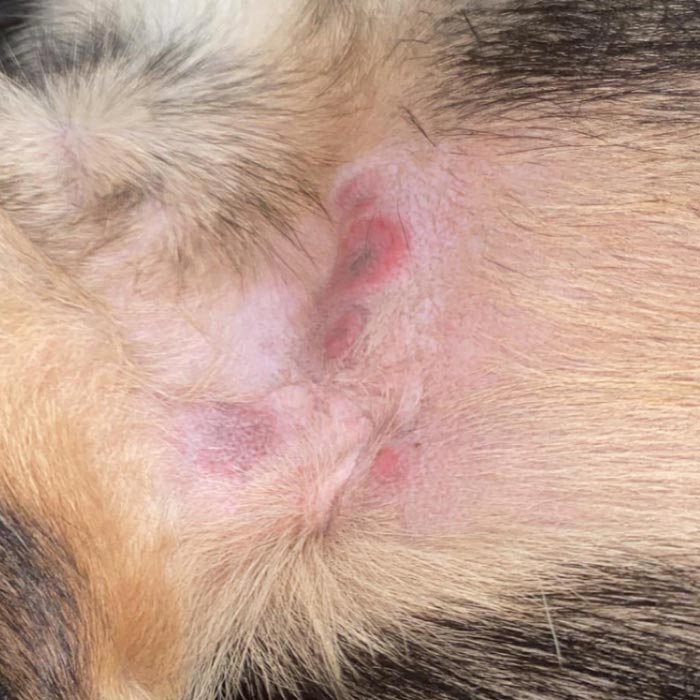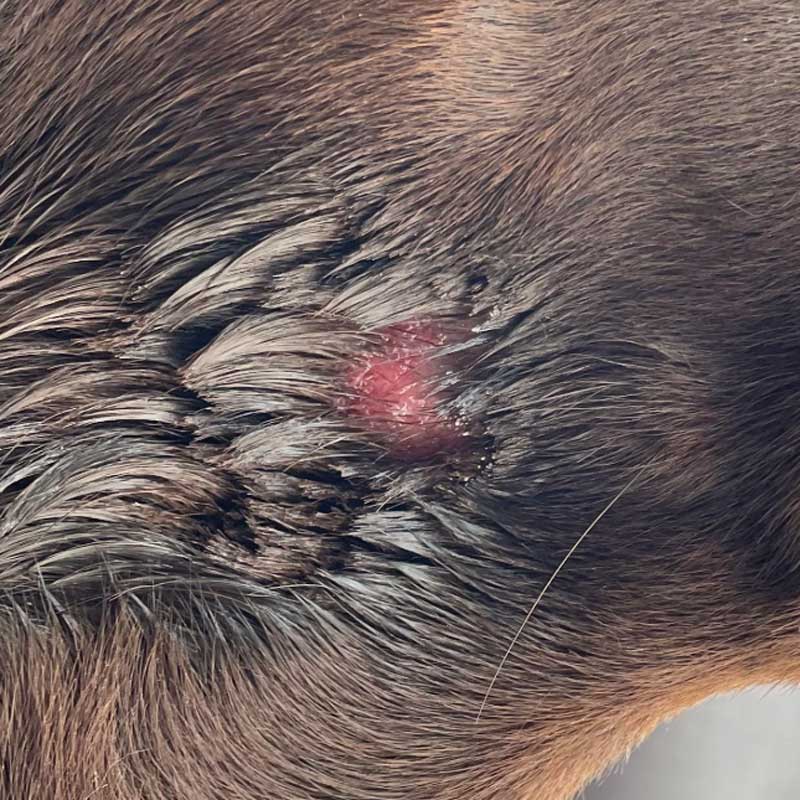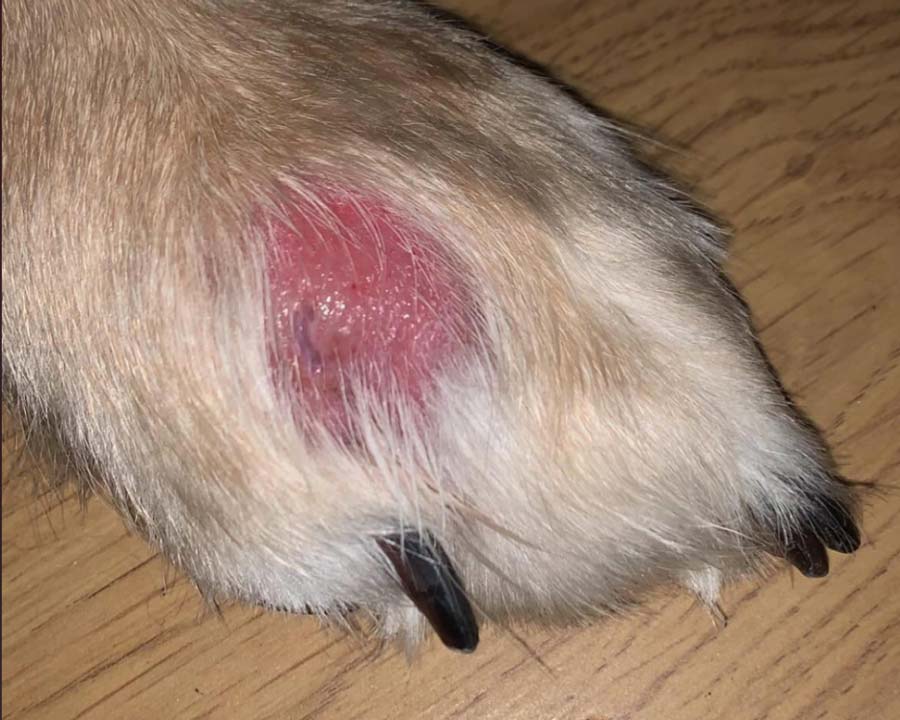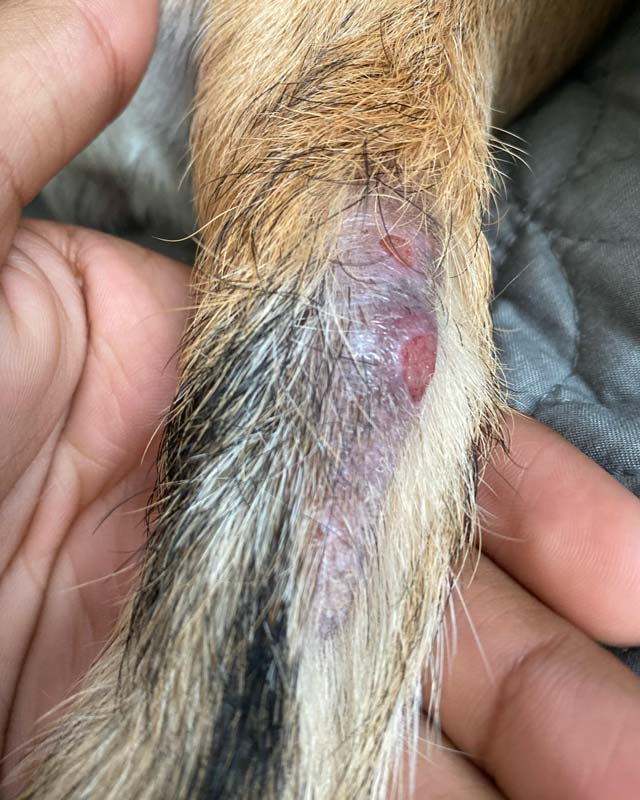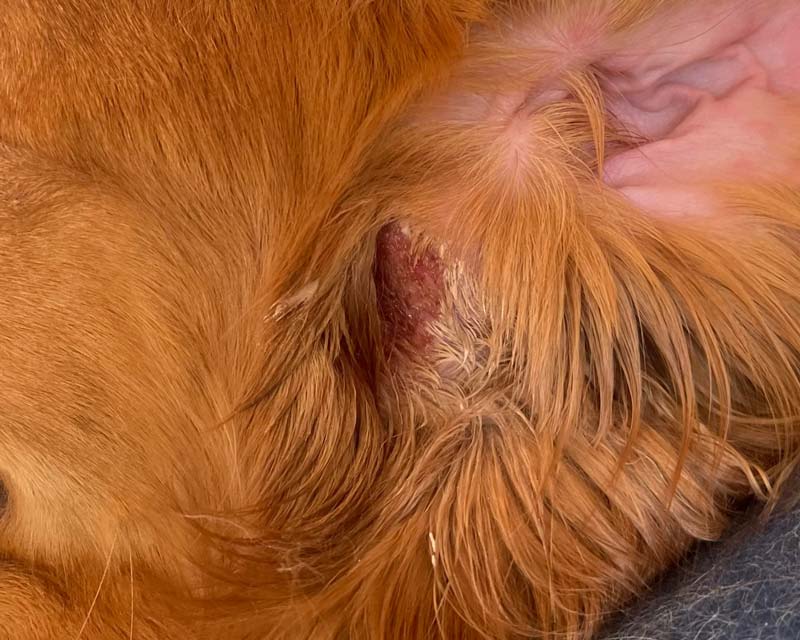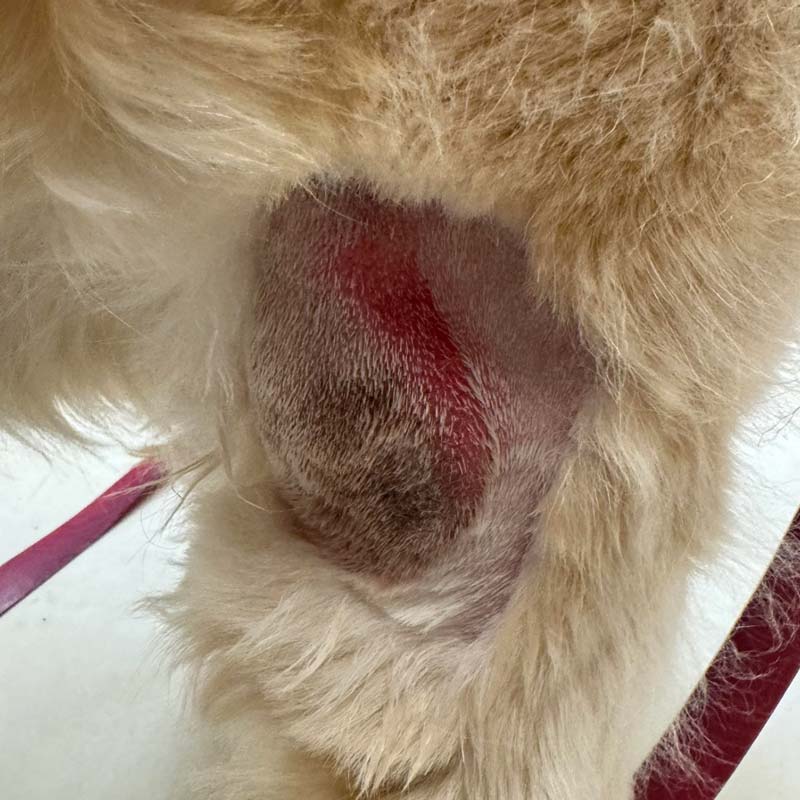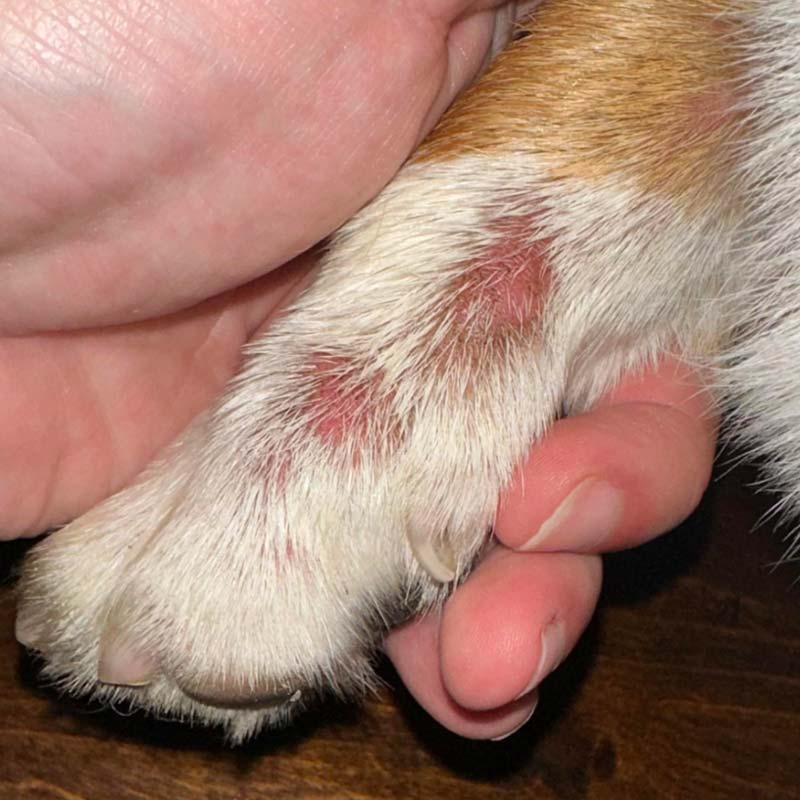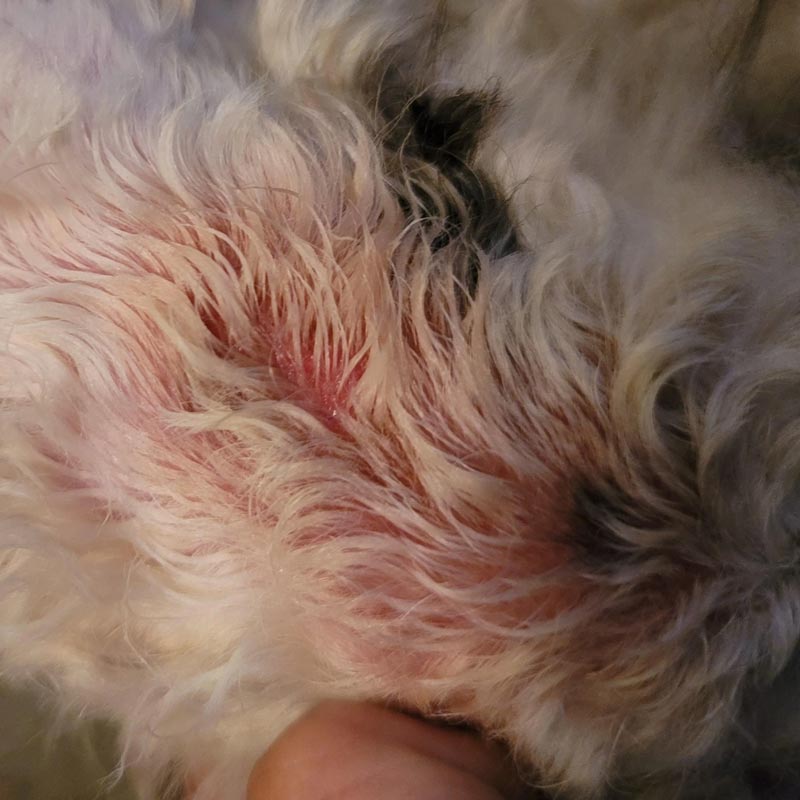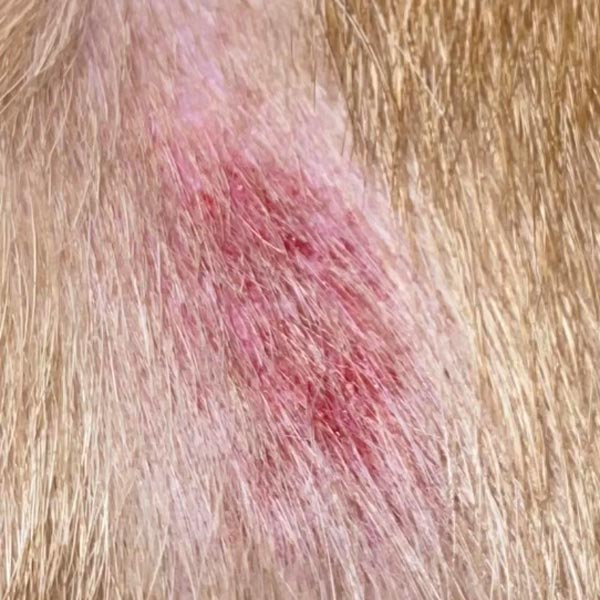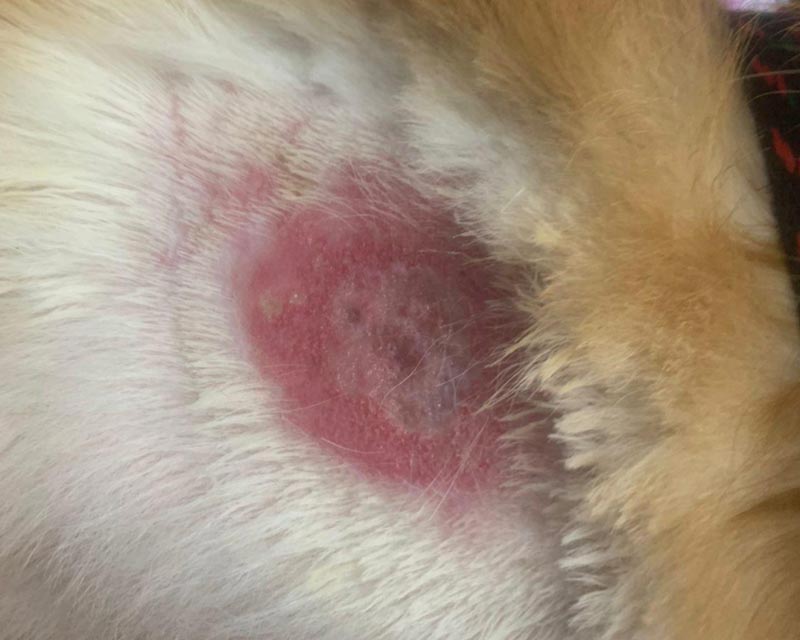Canine Hot Spots: Pictures, Solutions, and Prevention
For more info on these pesky red patches, see our Ultimate Hotspot Guide.
Remember, this is an educational resource, not a guide for diagnosis.
Pictures are helpful, but they may not tell the whole dermatological story. We always recommend consulting with your vet for any of your dog's health concerns.

What is a Hot Spot on a Dog?
Hot spots, also called acute moist dermatitis or pyotraumatic dermatitis, are red, inflamed, often shiny lesions created by consistent trauma to a specific area.
These raw, red areas are extremely itchy and can be very painful if left untreated. Hotspots are most commonly found around the head, neck, paws, hips, groin, and tail. Thinning or loss of fur are common in and around the spot.
Photo: Acute moist dermatitis on dog with curly fur, via r/lakiloe43 on Reddit
Lavengel® Can Handle Hot Spots
Key Symptoms of Canine Hot Spots
- Red and inflamed area of skin or sores
- Skin appears to be raw and ‘angry’
- Pus, blood, or discharge may be present - often signs of bacterial infection
- Hair loss (alopecia) and/or matted fur around the area
- Scabbing in and around the area
- Excessive licking and scratching at the area
- Your dog seems to be painful around this area
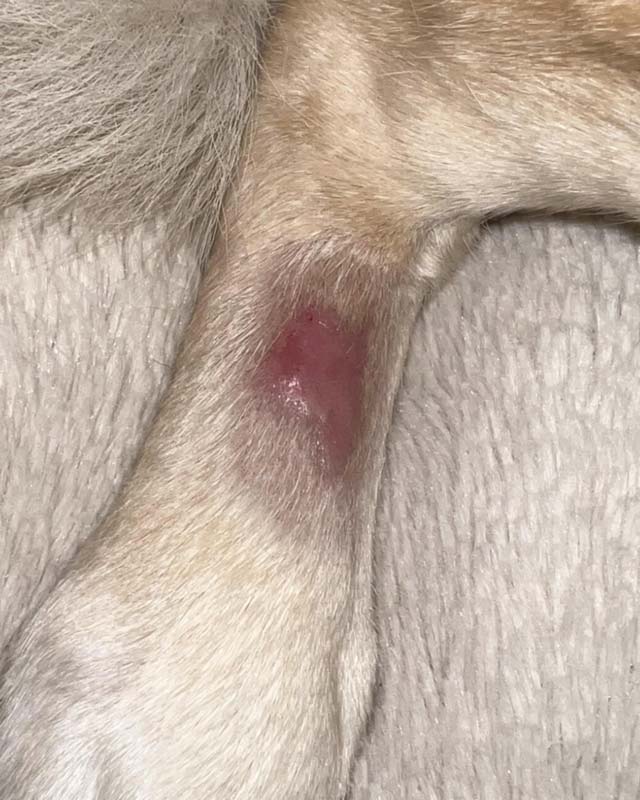
What Causes Hot Spots on Dogs?
Hot spots are created (and made worse) by a dog’s constant licking, biting, rubbing, or scratching at an itchy area. They can appear and set in quickly - many people remark that they seem to "appear overnight."
The initial irritation could come from:
- Allergies (seasonal, environmental, or food-related)
- Fleas or ticks
- Cheyletiella mites
- Mange mites
- Insect bites
- Bee stings
- Injury, scrapes, razor burn (from grooming)
- Moisture trapped under the fur or between skin folds
- Persistent rubbing from a collar or harness.
The broken and damaged skin also invites microbes that can cause infections and make the issue harder to treat.
Photo: Acute moist dermatitis on dog's hind leg, via r/blueberryJan on Reddit
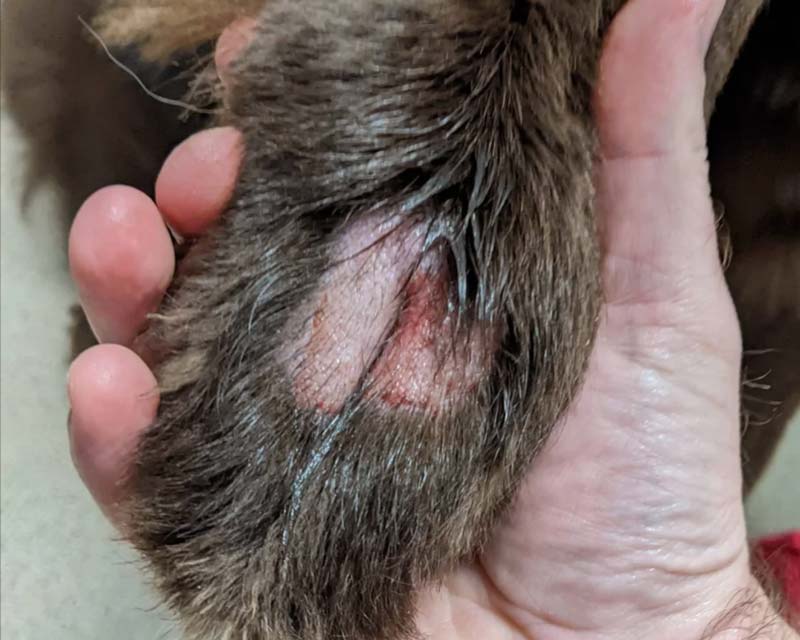
Can I Stop My Dog's Hot Spot from Getting Worse?
Yes! However, hot spots are best treated quickly before they can spread and infection can develop.
Stopping the repeated agitation is key. The more dogs lick, chew, and scratch at the spot, the worse it gets, and the risk of developing pyoderma (bacterial infection) or a yeast infection greatly increases. That's when things get bad - and expensive.
If you can relieve the discomfort that's causing all the "angst," you can stop a hot spot, and if you can provide protection from microbes, you can guard against infection. Lavengel® covers both of those 'ifs.' Plus, it can tackle an existing infection while providing the necessary micronutrients to mend the damaged skin and regrow fur.
Photo: Hot spot with fur loss on dog paw, via r/bulletmagnettn on Reddit
-
Lavengel's been a game-changer in treating hot spots and minor wounds.
-- K.P.
-
Healed my husky's hot spot quick!
-- Jennifer M.
Photo Examples of Hot Spots on Dogs
Below are a few examples of what acute moist dermatitis can look like.
However, it is important to remember that hot spots can resemble, and occur in addition to, other skin conditions. You will only obtain a full, proper diagnosis from your vet.
Dog Breeds Prone to Getting Hot Spots
Hotspots can happen to any breed of dog, but they tend to be more prevalent in breeds with thicker coats or numerous skin folds, such as:
How to Treat a Hot Spot with Lavengel®
If you notice your dog scratching at a specific area for a prolonged period, take a closer look. Like we mentioned above - and like many skin problems in general - the sooner you can catch acute moist dermatitis, the better.
Again, Lavengel® is an excellent means of countering canine hot spots at any stage - yes, even with infection.
Its natural lavender oil soothes the irritation and provides anti-inflammatory support, so dogs are less prone to itch and chew at the hot spot. Then, its powerful combination of antioxidants fight off microbes and provide the micronutrients needed to repair the damaged skin.
It's really as simple as these three steps:
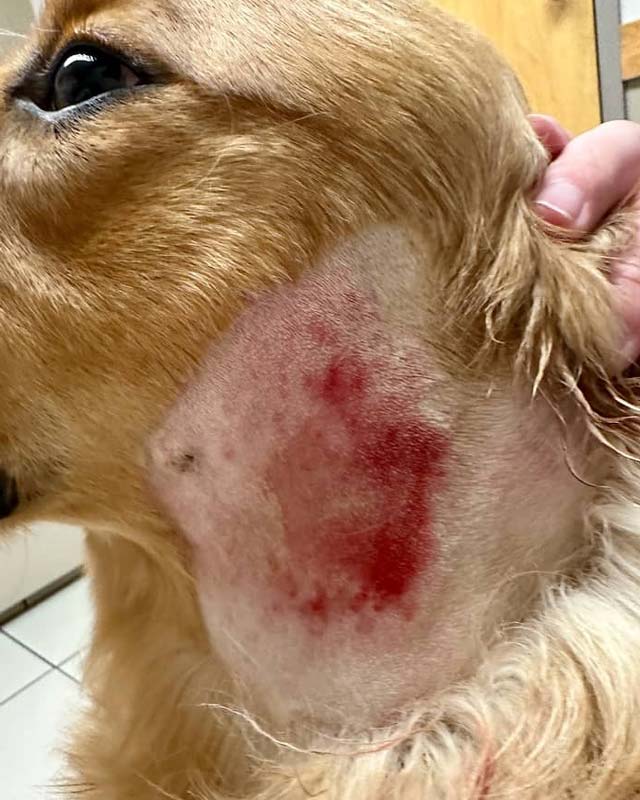
How Do I Prevent Hot Spots?
Here are a few things you can do to keep acute moist dermatitis at bay:
- Use Lavengel® on itchy spots to help heal and prevent them from worsening
- Keep your dog's fur well-groomed and, if needed, trimmed.
- Wrinkly breeds should have skin folds cleaned regularly to guard agains intertrigo.
- Make sure your dog is completely dry after a bath or being wet to prevent trapped moisture.
- Make sure collars and harnesses aren’t too tight and allow appropriate air flow.
- Keep them on a flea control/heartworm prevention medicine, even during the cold months.
- If your dog has seasonal or environmental skin allergies, see your vet about an oral antihistamine regimen.
- Be aware of any food allergies your dog may have.
- Disallow them from agitating a specific spot; this may require booties or an Elizabethan collar (cone or soft donut collar)
Photo: Hot spot on neck of Golden Retriever, via Kingsdale Animal Hospital
Dog Hot Spot FAQs
How do dogs get hot spots?
Hot spots come about due to excessive licking and scratching at a specific area. The initial cause of the itch could be nearly anything, but they are typically linked to:
- Seasonal or environmental skin allergies (atopy)
- Food allergies
- Parasitic bites (fleas, ticks, mites
- Bee or wasp stings
- Constant friction or rubbing from skin folds (intertrigo), clothing, collars, or harnesses
- Scrapes or wounds
- Razor burn from grooming
- Moisture trapped within the fur
- Anxiety
- Joint pain
Will my dog's hotspot go away on its own?
While it is possible for a dog's hot spot to go away on its own, it is unlikely, for it requires that the dog completely refrain from licking, scratching, or chewing at the area until the skin heals. If the hotspot is infected, there is a high probability that it will get worse if left untreated.
It is strongly recommended that hot spots are treated early and consistently until they are gone.
That's where Lavengel® comes in. It's powerful enough to soothe itch and heal the inflamed skin while being safe enough for dogs to lick without fear of gastrointestinal upset.
Can my dog's hotspot get infected?
Absolutely.
If anything, it is almost certain that a hot spot that is left untreated will get infected, as acute moist dermatitis provides an environment that is highly conducive to bacterial and fungal growth.
It is strongly recommended that hot spots are treated early and consistently until they are gone, and Lavengel® is a superb solution for that.
What if my dog's hot spot smells?
There aren't many spots continuously licked by a dog that will smell good, but if a dog's hot spot exhibits an especially foul odor, there's a good chance that a bacterial infection (also known as pyoderma) may be present.
What if my dog's hot spot has puss?
Puss in a dog's hot spot indicates pyoderma, or better known as a bacterial infection of the skin. It will need to be treated promptly, and you will certainly want to keep your dog from agitating it further.
Good news! Lavengel® can be an immense help with pyoderma. Here's why:
The majority of canine bacterial infections in the skin are caused by Staphylococcus pseudintermedius - a cousin to Staph aureus that primarily affects humans. Lavengel® has a U.S. patent - and multiple microbiology trials to back it - for its ability to hinder and kill Staph bacteria of both pseudintermedius and aureus species.
Are dog hot spots contagious?
No, canine hot spots are neither contagious to other dogs, nor humans.
However, it is possible that the original cause of the hot spot (what actually started the itch) can be spread, such as certain parasites like scabies mites, fleas, or ticks, or a fungal infection like ringworm.
Are dog hot spots fungal or bacterial?
Hot spots themselves aren't necessarily considered "fungal" or "bacterial," unless an infection has developed.
Hot spots are caused by repetitively licking and scratching an area of skin that's bothering them, which could have been caused by anything - a cut, bee sting, allergies, flea bites, or even anxiety.
The damaged skin of a hot spot makes a prime location for a bacterial infection (pyoderma) or fungal infection (such as Malassezia or ringworm) to develop. This adds to the irritation and makes dogs want to scratch and lick even more to soothe their skin, causing the lesion to grow.
Are dog hot spots dangerous?
Hot spots, like other skin wounds and disruptions, can become dangerous if they develop an infection. Infections, if left untreated, could spread and become systemic, affecting the whole body.
This is why it is best to treat a hot spot on your dog quickly with Lavengel®. It will greatly aid in soothing the itch, healing the skin, and guarding against infection.
Will my dog's hair grow back after a hot spot?
Yes, it is very likely that your dog's fur will grow back after a hot spot, especially if they generally have healthy skin and coat.
It requires significant damage to the hair follicles and lower layer of skin (dermis) to deter a healthy dog's hair from regrowing.
Dogs with compromised immune systems, malnutrition, or other skin disorder may not be able to regrow hair as quickly or easily.
Are there any home remedies for dog hot spots?
Let's put it this way:
If you're willing to spend the money and time to buy and mix up a bunch of random ingredients and/or essential oils in your kitchen, we will save you both money and time with a product that's just as natural and safe, with over 15 years of research and thousands of happy dogs behind it. That's Lavengel®.
Super Soothing Hot Spot Treatment for Dogs
Lavengel® provides quick, lasting relief and repair for skin affected by hot spots and other skin irritations. It's highly concentrated, safe for dogs to lick, and USA-made.
Free standard shipping on orders over $35
30-day money back guarantee
For every unit sold, we donate to help dogs + heroes








More Common Canine Skin Issues
-

Rashes + Dermatitis
Ew... tell me moreDermatitis, or inflammation of the skin, comes in many different forms. We've compiled a list of 10 types with photos and descriptions.
-
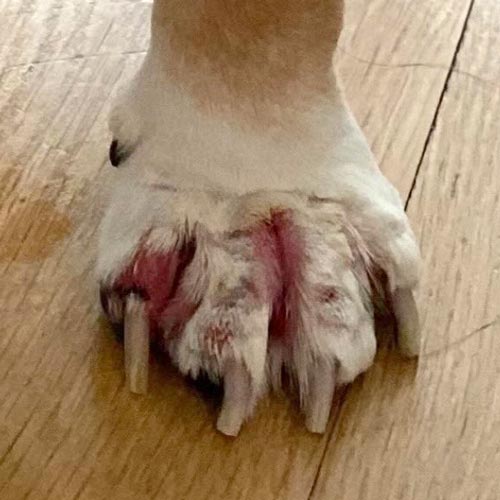
Paw Licking + Irritations
The best foot forwardEver wonder why dogs lick their paws so much? Or why their feet can appear so red, inflamed, and itchy at times? We've got answers!
-

Bacterial Infections
See the bacterial materialAlso known as pyoderma, these skin infections often occur in conjunction with hotspots, as bacteria invade broken skin and multiply.
Collapsible content
Photos
Photos for the "Examples of Hot Spots on Dogs" section were sourced from Reddit.
Photo credits (usernames), in order of appearance:
- r/[deleted]
- r/porterss25
- r/Spirited_Ad9924
- r/Straight-Key-4234
- r/Wilsoa10
- r/AventZyn
- r/Ducayne
- r/lostsoul_poly
- r/snowflakepr1ncess
- r/Jaded-Trick7939
For other photos, credit was either given in the corresponding section, or the photo was submitted to us by a customer.



